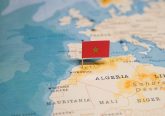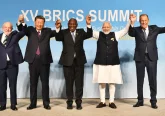Tony Blair’s establishment of the Africa Governance Initiative (AGI) has been lauded by reporters and bloggers as being indicative of a “new” way for the international community to engage with African countries to assist in poverty reduction and to move “beyond aid” by “attract[ing] sustainable investment” to the continent.
While the tenets of Blair’s AGI are fairly clear — focusing on strengthening African leadership and good governance and boosting economic growth through sustainable development of infrastructure — a visit to the AGI website is less than clear on how the initiative will (or can) ensure the necessary good governance. The AGI model can be summarized as:
Leadership (founded on skills, systems and structures)
+ prioritisation
+ planning
+ performance management
= delivery
There is a fundamental flaw, however, in the repeated focus on bolstering private sector development (presumably through foreign loans) as a means through which sustainable development and poverty reduction can be achieved for the bulk of African citizens. In fact, history has shown that immense amounts of money flow into African countries every year from foreign lending institutions has not provided development for local people.
A recent publication helps to grapple with this seeming paradox. The book is titled Africa’s Odious Debt, How Foreign Loans and Capital Flight Bled a Continent, authored by Léonce Ndikumana and James K. Boyce, and it considers the strange paradox between foreign loans and increased poverty in low-income countries in Africa. The central thesis of the book is that, through the system of loaning, borrowing, repayment, tax haven and corruption, Africa is, in fact, a net creditor to the rest of the world: “The External assets of these [African] countries exceeded their external debts” and that, “to a substantial extent, African capital flight [i.e. continuing poverty] has been debt fuelled” (p. 9).
Through an analysis of documents between 1970 and 1996, the authors of the book discovered that for every dollar of money loaned to African countries, as much as 80 cent departed the country in the form of capital flight that very year. The authors go on to illustrate that the remaining 20 cents of loan monies are used to finance white elephant projects, ‘ghost’ projects’ (i.e. fictitious roads, schools, soldiers, etc.), government salaries, ineffective development and infrastructural projects or it leaves the country through capital flight within the coming years — leaving little to nothing of actual development monies for the citizenry of these countries.
There are three acts, Ndikumana and Boyce argue, to the tragedy of international loaning in Africa. In Act I, foreign investors and African governmental officials collude in large-scale borrowing projects in the name of the local public. In Act II, all or most of these funds are diverted abroad. In Act III, African countries are required to repay debts for funds that were never used for their benefit and resources are expropriated from African economies and livelihoods for this repayment. This means, essentially, that Blair’s focus on international investment projects in Africa will possibly contribute to the continuing underdevelopment of African’s citizenry if good governance is not assured (again, it is unclear from AGI’s website or Blair’s press briefs on the subject how good governance is to be concretely guaranteed through loan agreements).
Stealing in the name of the public good
So, the history of international investment in many African countries has amounted to stealing in the name of the public good. These findings require a complete reassessment of the meaning of the word ‘loan.’ International investors are encouraged to loan money to African governments (which may or may not have a reputation for corruption, human rights violations and illegitimacy) because of the incredible incentives on the lender-side of the credit market: high interest rates, floating interest rates, loan origination fees, participation fees, etc. This has led to ‘loan pushing,’ when banks encourage unnecessary borrowing for profit, i.e. ‘selling money.’
The problem is that once the money arrives in African countries (presumably to be spent by the government for the betterment of the people of the countries) it is promptly misappropriated by corrupt public officials–through kickbacks, padded contracts, forged documents and other forms of fraud and thievery–who transfer the funds into secure bank accounts and/or private investments abroad. Once this corrupt system was established, it remained relatively unchallenged.
Zero net transfers and negative net transfers
In economic terms, many countries have experienced zero net transfers and negative net transfers. A zero net transfer occurs when “inflows from new international lending have roughly offset the outflows to service debts incurred in earlier years”; a negative net transfer is when a country “actually pays more in debt service than it receives in new money” (p. 36). This means that foreign loans are “a net drain on the economy, siphoning resources away from investment and consumption” (p. 36). But neither the African governmental officials nor the private foreign banks who made the decision to loan in the first place lose out, as European and North American governments step in to provide further financial assistance for African countries as they begin to lapse on loan repayments: “In effect, public money from the governments of industrialised countries […] helped to bail out the private creditors” (p. 33).
So, a cushion protects both parties in effectively stealing billions of dollars through a complex system, in the name of African people. The corrupt African leaders who profit from borrowing “find it in their interest to invest abroad”, where the stolen money cannot easily be (re)seized by their people. On the contrary, foreign investors are encouraged to participate in the system of thievery because it is exceptionally profitable and because foreign governments will step in to assure the African countries do not default on debt repayments (this paradox is what economists call ‘asymmetric risk’).
International loans fuel underdevelopment in Africa
More than $700 billion fled the continent between 1970 and 2008. Ndikumana and Boyce explain that, “If this capital had been invested abroad and earned interest at the going market rates, the accumulated capital loss for these countries over the 39 year period was $944 billion. By comparison, total GDP for all of sub-Saharan Africa in 2008 stood at $977 billion” (p. 38). A report by Christian Aid, Enough is Enough: The Debt Repudiation Option, hypothesises that had the money spent to service foreign debt “been spent on healthcare, education and infrastructure, the millennium development goals — which today seem like a fantasy — might have been within the world’s grasp” (p. 9). What we are left with is a system in which South Africans are paying for debt incurred during the Apartheid regime and Congolese citizens are repaying debts for money that was stolen by Mobutu Sese Seko.
Ndikumana and Boyce make a concrete connection between capital flight, debt service and negative health outcomes. They argue that “debt-service payments force governments to reduce public health expenditures [… and show that] each additional $40,000 of health spending is associated with one less infant death” in Africa (p. 82). Once calculated, this means that debt-fuelled capital flight has resulted in 77,000 excess infant deaths per year.
Strategies for the future
The system of international lending and subsequent capital flight must be stopped, and stopping it will be transformative for African peoples. When a bank assists an executive to defraud a corporation with the full knowledge of that act, the bank is held liable for the loss. Unfortunately no such provision exists or is even tentatively suggested by AGI.
However, African governments can draw on precedents such as the Cuban refusal to pay odious Spanish debt and the Tinoco arbitration (when Chief Justice Taft ruled that the Puerto Rican debt was illegitimate and had not been used to aid the people). They can use these strategies to demand that outstanding debts will only be treated as legitimate if the creditors can identify the debt counterparts and show that these counterparts either benefited the people or had a reasonable potential of benefiting them. An adoption of this method would also affect existing incentive structures within the international financial system as the risk of repudiating illegitimate debts would cause creditors to lend with increased caution, exercise due diligence and implement policies that encourage transparency of how the funds are used. Again, unfortunately, a push for financial transparency is lacking in AGI, which focuses almost solely on the importance of good African governance for self-development and fails to acknowledge (let alone condemn) the complacency of the international lending institutions.








3 Comments
Great article Amber. As an African, my experience has been that aid from former colonies and colonial outposts is often irrelevant, if not outright detrimental. While you write of aid as a form of investment, there is also aid as a form of ideology. For instance, USAid under Bush provided healthcare funds in South Africa conditional on not providing abortions, family planning and condoms.
I am far more interested in what we as Africans are doing for ourselves with regards to regional trade and investment. We have an incredible internal market of 1 billion people, and leveraging that market by improving internal transport, financial flows and harmonising regulation will do a great deal for us, methinks.
Adeel Malik has a very fine new article on the economics of the Arab Spring (although to be honest, demonstrations and uprisings have been pan-African this last year, rather than just pan-Arab). He argues that “overcoming regional economic barriers is the single most important collective action problem since that the region has faced since the fall of the Ottoman Empire.” Briefly, he contends that regional trade is crucial to a thriving private sector, which is in turn important for food security and employment. It’s definitely worth checking out:
http://www.csae.ox.ac.uk/workingpapers/pdfs/csae-wps-2011-23.pdf
Enjoy!
Thanks for your comments and for the link to this paper. Right you are: the ideology of foreign aid as somehow inherently “good” is disconnected from the reality of dependence and local detriment.
@bitterkomix: I returned to the link that you’ve provided above to the CSAE working paper and have some thoughts about the paper’s position. While the paper is well written, I have issue with some of the basic assumptions. Namely, the focus on bolstering private sector investment is problematic given the history of neo-liberal failure to increase employment or ensure social well-being (see the Occupy Wall Street Movement for an example of the devastation brought about through private sector’s unfettered growth in the USA, Western Europe and beyond – why turn to a broken model?).
From the CSAE paper: “…the unfolding crisis in the Middle East is not just about the Arab state – its failed efforts to redistribute, reform and represent ordinary citizen’s interests. It is also about the private sector – or, more appropriately, its absence. A singular failure of the Arab world is that it has been unsuccessful in developing a strong private sector that is connected with global markets, survives without state crutches and generates productive employment for its young” (p. 3).
How are we sure that cultivating a good business climate, albeit with a regional focus, will not simply optimise conditions for the capital accumulation of the upper classes (as neoliberal economic policies have proven since the 80s)?
From the CSAE paper: “The challenge of private sector development is traditionally viewed through a narrow technocratic and apolitical lens. When it comes to the Middle East, however, the limits of World Bank’s recipes are particularly evident [note from myself here: the World Bank’s policies are often referred to as the “Washington consensus”, meaning that they represent Western business interests]. Private sector development is not simply a matter of improving investment climate, reducing the cost of doing business, offering cheap credit, or introducing market friendly economic reforms. It is also a political problem…” (p. 3-4).
This, again, is the same logic of Western neoliberalism which caused the severe economic recessions in Western Europe and the United States. Many authoritarian Arab elites do subscribe to the same ideologies (i.e. economic liberalization) that this paper is promoting and others have argued that this was precisely these ideologies that caused the Arab Spring. The Berkely Political Review posted an article by Nader Atassi which argued essentially just this point. How do we address the fact that in Egypt, privatization meant that the already affluent elite could purchase state-owned assets for “much less than their market value.” This has been the history of market liberalism – a history that is absent from this working paper.
From the CSAE paper: “… Africa provides a striking contrast. Like the Middle East, it is both rich in natural resources and a severely fragmented region. But Africa is divided by ethnicity and geography. Its ethnic fractionalization and adverse geography, though landlocked regions and sparsely distributed populations, limits the possibilities for trade. About 40 percent of Africa’s population lives in landlocked countries. Its recourse riches have fuelled internecine civil wars. Ethnic divisions, rooted in the history of slave trade, have weakened trust among communities and led to the under-provision of public goods” (p. 13)
This is an oversimplification of the divisions among Sub-Saharan African countries, methinks. International trade brought Western Europe and Africa into contact in the late fifteenth century. From the beginning, Europe exploited this trade relationship—which Walter Rodney refers to as the robbery of Africa in his important work, “How Europe Underdeveloped Africa”. First, Europe assumed the power to create international trading laws that allowed them to establish the price of products and freight rates. Europe painstakingly separated pre-existing local trading systems so that Africans were required to sell goods to European middlemen who then re-sold the goods for a profit to neighboring Africans. Second, Europe established total ownership of the means of production, this entailed European ownership of African land, minerals, banks, factories, mines, newspapers, means of transport and power stations. Third, Europeans controlled trade with a complete loan monopoly wherein they expected huge profits in the form of interests. During this historical period, exchange with Africa unequivocally promoted European development by contributing large amounts of raw material (gold, ivory, gum, land, human labor) to Europe’s economy. This large influx of product stimulated further advance in Western European society: as factories were pressured to refine goods, science responded to create new technologies; these refined products were then sold to the developing middle-working class and profits were poured back into the European economy, causing further stimulus. Europeans made advancements in their ship building capacity and expanded their port systems (Rodney 1972).
Furthermore, we know that many “ethnic” divisions were socially exploited and exaggerated during colonialism in Sub-Saharan African nations as a means of pitting diverse peoples against each other to best suit the interests of colonialism. Therefore, such “ethnic” divisions should be elaborated upon and at the very least reference should be given to their use as historical tools (see extensive scholarly work on the development of the Hutu/ Tutsi “ethnic” divisions by the Belgians, for one powerful example).
Thank you for encouraging me and pushing me to rethink these concepts and events, it has been a pleasure.